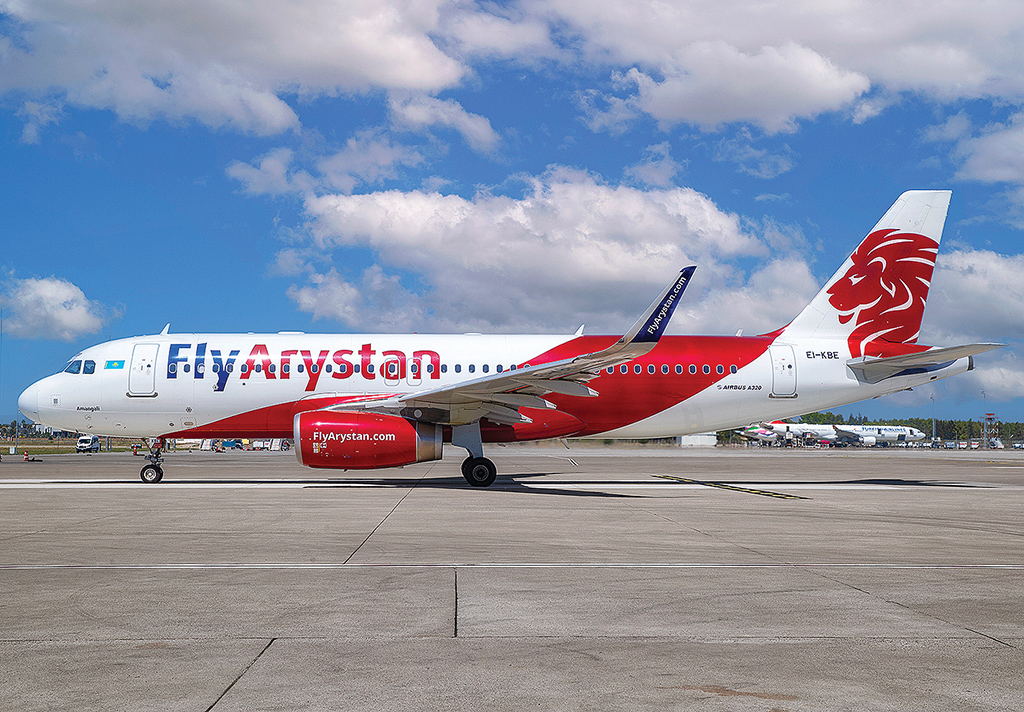
Kazakhstan is the ninth-largest country in the world, with an area of 1.05 million sq. mi., and also the largest landlocked country. While rail provides most of its transport links for cargo and people, Kazakhstan’s air transport network domestically and internationally is growing.
A former Soviet republic, Kazakhstan’s borders stretch from the Caspian Sea in the west to the Altai Mountains on its eastern border with China and Russia. The border between Kazakhstan and Russia is 4,750 miles long. For the 19 million inhabitants, who on average fly just 0.3 times a year, Almaty, is the largest metropolis and an important trading hub, while Astana is the capital.
Kazakhstan has 20 airports, with 18 of them open to international commercial flights and which are either government-owned or privately owned, except for Aktau International Airport, which is owned by a public-private partnership.
According to Aviation Administration of Kazakhstan (AAK) director general Catalin Radu, there are 920 aircraft on the Kazakhstan civil aircraft register, of which 17% are airliners.
AAK data show steady year-on-year growth in commercial passengers on Kazakh airlines, from 7.3 million in 2019 to 9.5 million in 2021 and almost 11 million in 2022—a 17% increase.
AAK was created and given oversight powers in 2019 as part of the country’s safety reforms, which have been modeled on EU standards. The project has included technical partnerships with Airports Council International, Boeing, EASA, IATA, ICAO and the Irish Aviation Authority.

“Kazakhstan has achieved 84% effective implementation of ICAO standards and recommended practices following an ICAO audit in August 2021, which is now 15% higher than the global average,” Radu said.
Air Astana And FlyArystan Growth
Air Astana and its LCC subsidiary FlyArystan are the country’s largest airlines, with a combined fleet of 44 aircraft. SCAT is the second-largest, with 34 aircraft, while Qazaq Air has five.
Established in 2002, Air Astana is one of the largest airline groups in Eurasia by revenue and fleet size, operating a fleet of Airbus A320neo family aircraft, Embraer E195s and Boeing 767s.
Air Astana president and CEO Peter Foster told ATW during a media briefing at the airline’s Almaty base that the pandemic presented the company with a unique opportunity to refocus and reconfigure its strategic plans for growth. By embracing this, the group recovered at a faster rate than in many other global markets and saw passenger traffic on domestic and international routes up 44% by the end of 2022 versus pre-pandemic levels, transporting 4.1 million passengers on 48 routes.
“We speak about one of the fastest-growing aviation markets in the world,” Foster—a former Cathay Pacific executive—said.
Air Astana is now preparing for the introduction of Boeing 787s into its fleet in 2025. The carrier will upgauge to the larger 787-9, instead of the originally planned 787-8, that will have 263 seats.
“We have three 787s on order initially, though we expect the fleet to expand,” Foster said. The 787s will initially be deployed on existing 767 routes. By the end of 2025, Air Astana hopes to operate to New York, although nonstop flights could be stymied if Russian airspace remains closed to the carrier, which ceased all operations to, from and over Russia in March 2022, shortly after Russia invaded Ukraine. If the situation continues, the airline may choose to make a midpoint stop at Aktau—on Kazakhstan’s eastern Caspian coast—to serve oil-related traffic to and from that region, as it does on flights to and from London.
For the New York flights to go ahead, Kazakhstan’s airports will require US Category A certification. Radu said work to launch flights to the US began in 2021. The country has hosted two visits from the US Transportation Security Administration and the US Embassy’s Export Control and Border Security Program. In October 2021, US experts also visited Astana and Almaty airports to assess their aviation security systems.
Air Astana became an early Airbus A321LR operator in 2019 and operates the aircraft to its maximum range on several routes. The airline is evaluating whether to increase the range of the narrowbodies by fitting an additional center tank to the aircraft. The resulting extra range would give Air Astana the possibility of operating routes from Almaty to Tokyo and/or Paris.
When asked about the new A321XLR extra long-range aircraft, Foster said, “It might be a good fit for us, subject to final certification and payload range confirmation.”
Meanwhile, the airline plans to phase out its five Embraer E190-E2s in 2024-25, since FlyArystan has no further need of the regional jets.
Kazakhstan has not escaped the industry’s widespread supply chain and maintenance issues that have also forced capacity and scheduling constraints despite strong resurgent demand for air travel.
Foster said the carrier continues to experience long delays for deliveries of both aircraft and engines, in particular its fleet of A320/321neos and accompanying Pratt & Whitney PW1100 engines.
“The PW1100 issue has become a sort of chronic illness with which we have had to learn to live,” he said.
Yet despite the suspension of flights to Russia and Ukraine and limited China operations, Foster said 2022 “has been the most successful year for the airline thanks to quick and efficient reallocation of capacity.”
The commercial strategy for the group focused on maintaining growth through the redeployment of resources to support the increased passenger demand for developing “lifestyle” routes, such as Turkey, Sri Lanka or Montenegro, as well as serving a growing domestic market.
“Air Astana is a different beast today with a different network,” Foster said, adding that the carrier plans to almost double its fleet size to serve a more than twofold increase in passengers by 2026.
Different Models
FlyArystan also benefits from a strong domestic market.
“Flying has became the first choice for traveling in Kazakhstan,” FlyArystan managing director Adrian Hamilton-Manns told ATW at Almaty.
Established in 2019 to stimulate the underdeveloped domestic market within Kazakhstan, FlyArystan continues to grow in its native market and to markets in the Central Asia and Caucasus regions. The carrier is planning to base aircraft in neighboring countries or establish joint ventures similar to those managed by LCCs in Europe and Asia.
“We have looked at many different models—the joint venture model or the airline basing model,” Hamilton-Manns said.
The basing model—operating from a chosen airport—would be the easiest thing to do, he said. “But then you have to work through restrictions enabling you to fly on routes.”
Obtaining traffic rights would be the biggest challenge. On the other hand, he said, joint ventures bring complications, but they give the LCC traffic rights.
“So, if you do the aircraft basing, then you don’t have headaches, but it doesn’t give you many traffic rights,” Hamilton-Manns said. “For the joint venture model you need a partner.”
The airline is still deciding which model would best fit its needs, he added.
When talking about specific countries to start operations, Hamilton-Manns said Georgia is hot on the carrier’s radar.
“The whole issue right now is that this region is experiencing political uncertainty and instability,” Hamilton-Manns said. “It is prudent for us to be a bit cautious.”
He notes other nations have already seen a boom in new carriers. “Uzbekistan has suddenly become the largest LCC startup in the world; nine carriers are planning to start, four are already operating,” he said.
Other possibilities are in Turkmenistan and Tajikistan, which have limited air travel connectivity.
“Our flight model is to operate lots of flights, lots of seats, building up new demand,” Hamilton-Manns said. “It really worked well in Kazakhstan; it is phenomenal.”
The plan would be for FlyArystan to start with one international base and grow from there. “Whether or not other airlines are there, this really doesn’t matter because we build our own path.” Hamilton-Manns said.
Foster pointed out that “LCCs are not limited to their home market. Wizz Air comes from Hungary, which is a small country; Ryanair comes from Ireland, which is an even smaller country and is now one of the largest carriers in the world. This demonstrates that LCCs do travel.”
Hamilton-Manns said FlyArystan operates with 95% load factors. “That’s why we speak about the A321neo,” he said. “But for the next two years we are locked in with the A320 platform.”
Domestic operations account for about 85% of FlyArystan’s activities. “The overall market tripled in size from 2.5 million a year to now 8 million. We expect to transport 4.5 million this year, up from 4.2 million in 2022,” Hamilton-Manns said.
FlyArystan operates under Air Astana’s AOC, which brings great efficiencies, but with plans for the LCC to double its Airbus to 30 aircraft in two years, FlyArystan wants its own AOC.
“We are aiming to receive the AOC by the end of the year. We have all the systems in place, and we are already larger on the passenger side than Air Astana,” Hamilton-Manns said.
Another important airline in Kazakhstan is SCAT, based at Shymkent International Airport in the south of the nation, which operates a fleet of around 30 aircraft comprising Boeing 737 classics, 737NGs, 737 MAX 8s and 9s, 757s, and 767s, as well as Bombardier CRJs. The 767s are utilized for SCAT’s charter subsidiary, Sunday Airlines.
According to AAK, SCAT plans to purchase 32 new aircraft between 2023 and 2030 and add 14 international flights.
While the underlying trend of the nation’s aviation system is undoubtedly one of growth, local issues have posed constraints, albeit short-lived.
In January 2022, Kazakhstan was put under curfew because of civil unrest. While this was a temporary move, airports were closed and flights cancelled for over a week. Russia’s invasion of Ukraine brought additional challenges that are longer-lived, and which have caused the disruption and rerouting of flights as well as international sanctions that have impacted supply chains.
“The war has shifted the center of gravity of the hubs from Moscow and Kyiv to Istanbul, the Gulf and to Kazakhstan, resulting in more traffic,” Foster said.
There is, for example, limited air service from Moscow to Tel Aviv, and Air Astana´s new route to Israel could benefit from that.
“All our offices in Russia are closed, it is not possible to buy Air Astana tickets in Russia,” Foster said. The same is true for FlyArystan.
A lot of Russians live in Kazakhstan. If the war ends, Russia will be a different market and Air Astana most likely will return to it. SCAT, meanwhile, continues to fly to Russia.
Meanwhile, Air Astana opened a flight training academy, the first EASA-certified training center in Kazakhstan, at Astana Airport in early July. The center has an L3Harris A320/321 full-flight simulator installed, with a second planned.





